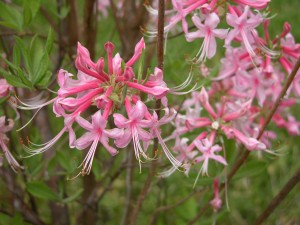Roseshell azalea (Rhododendron prinophyllum, formerly R. roseum) is native from New England, a number of Midwestern states, south to Texas. In its natural habitat it is commonly grows on wooded, north-facing slopes, shaded ravines, or nearby a cool mountain stream. The plants are not stoloniferous.
Roseshell azalea grows best in organically rich, acidic, well-drained, and moderately moist soils. It thrives in morning sunlight, and should be partially shaded in the afternoon. It struggles in dry soils and high heat areas; Southern forms are being studied. Maintain a 2-3 inch organic mulch (e.g., bark, oak leaf or pine needle) to retain soil moisture and cool temperatures.
This upright growing shrub averages 4 to 8 feet in height and width. Prune as needed to manage shrub size. Leaves are bright green on the surface and covered with tiny hairs beneath; it is sometimes nicknamed “downy azalea”. Foliage turns copper brown in fall.
Flowers range from pale pink to dark vibrant pink and open slightly ahead of the foliage in May and June (date depending on location). Floral trusses average 5-9 flowers, each to 1.5 inches long. Hummingbirds and butterflies are attracted to the tubular flowers which emit a pleasant sweet clove-like fragrance.
Roseshell azalea is one of our hardiest native azaleas. The University of Minnesota bred the winter hardy Northern Lights hybrids using roseshell azalea as one of the parents. Western forms native to Oklahoma and western Arkansas are more heat tolerant and have been successfully trialed in Athens, GA area.
Use Roseshell azalea as a specimen or group several together in a woodland setting or as part of a foundation planting. While susceptible to numerous disease and pest problems, roseshell azalea performs well when located on a cool, partially shaded site.


 Posted in
Posted in 
